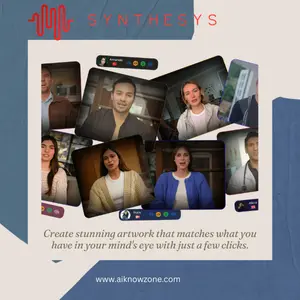
Diffusers
Discover how Hugging Face’s Diffusers library empowers you with state-of-the-art diffusion models for all your generative AI needs. From image generation to audio creation, find out if Diffusers is right for you!
Description
Diffusers Review: Your Gateway to Generative AI 🎨
Ever dreamt of effortlessly creating stunning images, realistic audio, or even 3D models with just a few lines of code? Well, buckle up, because Diffusers by Hugging Face might just be your magic wand! ✨ This isn’t just another AI tool; it’s a comprehensive library packed with state-of-the-art, pre-trained diffusion models designed to empower everyone, from seasoned researchers to budding AI enthusiasts. Diffusers stands out because it provides a modular and accessible toolkit for diving deep into the world of generative AI. The focus of Diffusers is on providing the tools and models to generate continuous outputs, such as vision and audio, making it modality independent. Whether you’re aiming to generate breathtaking landscapes, compose unique musical pieces, or even explore the structural intricacies of molecules, Diffusers offers a flexible and user-friendly platform to bring your creative visions to life. The platform gives diffusion models and schedulers that are provided as concise, elementary building blocks that you can work with.
What truly sets Diffusers apart is its commitment to being a toolbox for the diffusers models. If you encounter any limitations with the current API or desire additional models, schedulers, or techniques, the developers encourage you to open a GitHub issue. The open-source nature of Diffusers fosters a collaborative environment where users can contribute to the library’s evolution and ensure it remains at the cutting edge of generative AI. It’s designed with the user in mind, making complex diffusion techniques surprisingly approachable. So, if you’re ready to unlock the power of generative AI and explore the boundless possibilities of diffusion models, keep reading!
Key Features and Benefits of Diffusers 🌟
- Pre-trained Diffusion Models: Access a vast collection of state-of-the-art diffusion models ready for immediate use. This saves you countless hours of training and experimentation, allowing you to jump straight into generating impressive results.
- Modularity and Flexibility: Diffusers is built on a modular architecture, giving you the freedom to customize and combine different components to suit your specific needs. Swap out schedulers, experiment with various noise functions, and fine-tune parameters to achieve your desired outcome.
- Simplified Inference: The Pipeline class provides a user-friendly interface for performing inference with pre-trained models. Generate images, audio, and more with just a few lines of code, abstracting away the complexities of diffusion model implementation.
- Community Support: Benefit from a vibrant and active community of developers and researchers. Access extensive documentation, tutorials, and example code to help you get started and overcome any challenges you encounter. Plus, with its open-source nature, you can contribute your own improvements and extensions to the library.
How It Works (Simplified) 🛠️
Getting started with Diffusers is surprisingly straightforward. First, you’ll need to install the library using pip or conda. Then, you can load a pre-trained diffusion model using the `from_pretrained` method, choosing from a wide range of models available on the Hugging Face Hub. Next, you use the Pipeline class which makes it super easy to generate outputs. To generate an image from text, use the from_pretrained method to load any pretrained diffusion model (browse the Hub for 19000+ models!). To generate your output, provide your input (e.g., a text prompt) and let the library do its magic. You can fine-tune various parameters to control the generation process, such as the number of steps, the guidance scale, and the random seed. Finally, save or display your generated output and share your creations with the world!
Real-World Use Cases for Diffusers 🌍
- Generating AI Art: I’ve personally used Diffusers to create unique digital artwork from text prompts, turning simple ideas into visually stunning images. It’s incredibly satisfying to see your imagination come to life! I wrote a prompt to try to recreate my puppy in a superhero style!
- Audio Synthesis: I can create unique soundscapes and musical compositions by manipulating audio signals using Diffusers’ diffusion models. The possibilities are endless and allows you to experiment with new sounds.
- Scientific Research: Researchers are leveraging Diffusers to generate realistic 3D models of molecules, aiding in drug discovery and materials science. This helps visualize the structures of the molecules.
Pros of Diffusers 👍
- State-of-the-art pre-trained diffusion models
- Highly modular and customizable architecture
- Simplified inference with the Pipeline class
- Extensive documentation and community support
- Open-source and continuously evolving
Cons of using Diffusers 👎
- Can be computationally intensive, requiring powerful hardware for optimal performance
- Steep learning curve for beginners unfamiliar with diffusion models
- The library is rapidly evolving, which means some updates may break backward compatibility.
Diffusers Pricing 💰
Diffusers is an open-source library and is free to use. However, running the models, especially for training or generating high-resolution outputs, may incur costs related to cloud computing resources or specialized hardware.
Conclusion 🎉
In conclusion, Diffusers is a powerful and versatile library that democratizes access to state-of-the-art diffusion models. Whether you’re an artist, musician, researcher, or simply someone curious about generative AI, Diffusers offers a wealth of tools and resources to explore your creative potential. While it may require some technical expertise to fully master, the rewards are well worth the effort. So, dive in, experiment, and unlock the magic of diffusion models with Diffusers! 🚀





Reviews
There are no reviews yet.